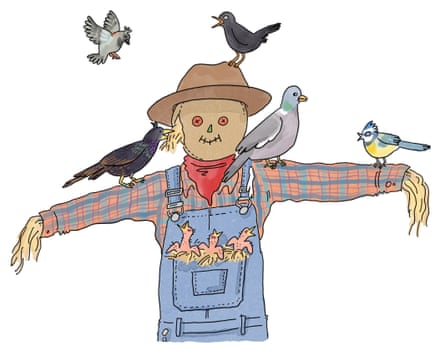As any gardener knows, we share our outdoor spaces with a vast array of creatures. This is mostly a wonderful and necessary thing. The majority of beasts are beneficial and ought to receive the warmest of welcomes. And given the biodiversity crisis, we must reconsider who we regard as a “pest”. Having said that, there are organisms whose presence can imperil our garden plans.
When I was studying the principles of growing food organically, I was taught a systems approach to dealing with so-called pests: choose your interventions carefully and opt for the least disruptive before considering more drastic measures.
Encouraging wildlife into your garden is the first step to limiting pest damage, as a balanced ecosystem will see naturally occurring predators manage the creatures that bother your plants. Alongside this, raising strong plants and ensuring the soil they’re growing in is healthy will result in a more resilient patch.
If there’s a creature that reappears every season, or you’re growing a plant that is of interest to a certain insect, installing a physical barrier to protect your plants from damage can limit interference with the balance of the garden’s ecosystem. The carrot root fly, for example, can be stopped using insect-proof mesh.
Despite our best efforts, it’s inevitable that sometimes we don’t spot damage until it’s already done, but I’d encourage you to avoid chemical measures that would cause destruction to the surrounding environment, or lead to the wholesale eradication of any population, which might then disrupt the food webs they’re part of. Before you attempt whatever quick fix the social media algorithm has sent your way, read on for interventions that have a decent chance of working.
Will eggshells and coffee grounds protect my plants from slugs and snails?
How to manage slugs is my most-asked question, even though the Royal Horticultural Society has stopped describing these molluscs as pests, and says that only nine of the estimated 44 UK species of slug are “notable plant nibblers”.
In my experience, coffee grounds and eggshells do little to protect plants. Beer traps do work in that they coax slugs into a yeasty, watery grave, but they require monitoring, emptying and refilling, which is not a pleasant task. How effective they are depends on how many you put out and the size of your slug population.
What does work is limiting places for slugs and snails to hide near your plants (wooden edging, bricks, pieces of wood), and encouraging predators such as frogs, newts and toads by installing a pond and maintaining wild areas for the amphibians to hunt in. Nematodes are also effective, but only in contained spaces because biological control (introducing organisms in places where they would naturally occur to boost the population) doesn’t really work without boundaries.
As for using wool to deter molluscs, I visited a gardener last year who claimed that surrounding tender plants with it had proved successful, but I suspect that it wouldn’t remain effective after heavy rain or watering.
Will peeing in the garden deter foxes?
I once worked on a growing space where foxes would chew through and rearrange our irrigation pipes weekly. It was infuriating, and if I’d had access to adequate volumes of urine to deter them I might have given it a go, as the smell can disrupt the boundaries of their territory and urge them to move elsewhere. Given how accustomed city foxes are to humans, this might only work in the countryside. Also, you would probably need to be weeing outside every day for it to put them off.
A better approach would be to plug the holes in your fences and secure your bins to make your garden and food sources less accessible. If you find fox poo on your beds, try using chilli and garlic as a deterrent as they hate the smell, and cover any bare soil with holly clippings to make for a less comfortable toilet.
Will my old CD collection keep birds from eating my strawberries?
Birdwatching is a principal pleasure of spending time in green spaces. Unfortunately, some species are as interested in the kale and strawberries we grow as we are.

CDs or recycled foil hung around the garden will reflect light and keep birds off crops, but my go-to solution is bird-proof netting, carefully secured at the edges or installed over a cage so they don’t sneak under and then get stuck.
A traditional scarecrow might work for a short time, but the birds will get used to it. I reckon an inflatable dancing tube man would do a better job if you’re happy for your garden to look like a forecourt selling secondhand cars.
Is using pesticide the only way to protect brassicas?
A few different butterflies and moths lay their eggs on the underside of leaves in the brassica family. When those eggs hatch into caterpillars, it can be a matter of days before a robust purple sprouting broccoli is reduced to a skeleton. Large and small cabbage white butterflies appear in my veg patch without fail every year and are the reason my 2023 season was entirely kale-free.
Butterflies and moths are an important food source for many animals, including bats, so ideally our efforts to protect crops ought to encourage them to lay their eggs elsewhere. The most effective approach in my experience is fine, insect-proof mesh, which also stops pigeons from stripping leaves. And try planting nasturtiums as a companion plant because, despite them not belonging to the brassica family, large and small whites will lay their eggs on them, too.
Can I simply wash aphids off my plants?
Sap-sucking insects that feed on new plant growth cause distortion and stunted growth; they also invite disease. There are various species, and they feed on a wide range of plants, so they’re a common sight. These insects are, in turn, a food source for other creatures – including ladybird larvae, lacewings, hoverflies and insectivorous birds – so I tend not to panic when I see them as I’m fairly certain their predators will be along soon to keep their population in check.
Pinching out the tips of plants, growing sacrificial plants such as nasturtiums, and gently washing the aphids off with water are low-intervention methods. Avoid using so-called “natural” remedies such as neem oil, which will kill insects beyond the target species.
Is the only way to get rid of a mole to call the ‘mole man’?
Like ants, moles aren’t after your plants, but what they get up to beneath them can be devastating. These rampant little burrowers feast on soil organisms such as earthworms, and if you’re actively encouraging soil life with generous amounts of compost, it’s no great surprise that a mole might move in.

As they are territorial, it’s likely you have only got one mole burrowing around your garden, and the main, humane way of encouraging it to move along is to get on its nerves. Moles are extremely sensitive to vibration and noise, so you can buy devices to stick into the ground that buzz regularly, or commit to a daily stomping ritual around your plot and hope that does the trick.
A neighbour did once offer me the number of the “mole man”, but I’d rather have an empty veg plot than the death of a mole on my conscience.
Does boiling water get rid of ants?
Ants aren’t really a bother in themselves (although a red ant bite can be a nasty surprise), but they can make your aphid problem worse. Ants “farm” aphids by moving them to your plants so they can feed and breed, then the ants feed on the aphids’ honeydew (the sweet substance they excrete – yuck!)
Ants like to nest in dry soil, so mulching regularly to ensure your soil is moisture-retentive can discourage them from setting up home near your plants. If they’re already there, keeping the soil moist (but not drenched) will encourage them to move on. Boiling water can kill ants, but that’s cruel and unnecessary.
Do I need to get a cat to save my beans from hungry mice?
Whether you’re growing in the countryside or the city, mice will be nearby. They are happy to munch on so many different plants – from germinating peas to newly planted bulbs – that once they’ve got their teeth into your planting plan, it can be enough to make you give up on gardening.
These rodents can be a challenge to manage and, yes, a cat would be very helpful. But if, like me, you’re seriously allergic to felines, try using row covers or fine mesh pinned down diligently. I have also found that – as with foxes – laying plenty of prickly holly clippings around plants does the trick.

 18 hours ago
2
18 hours ago
2










 English (US)
English (US)